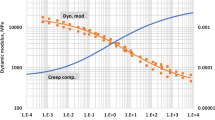Abstract
An analytical model for deducing the actual stress-strain properties from laboratory test results is discussed. As an illustration, an elastic bilinear material is used for unconfined cylindrical compression test conditions, as simulated with a finite element analysis. The results obtained are applicable for assisting in evaluating measured strength and stiffness properties of some clay soils, concrete test cylinders, concrete cores, and rock cores.
The quantitative results of this study can be used for interpreting measured stress-strain data for unconfined compression test conditions. The error in measured results is shown to be influenced by Poisson's ratio, length-to-diameter ratio of the specimen, end condition, and ratio of inelastic modulus to initial elastic modulus. Curves for adjusting the measured results to the theoretical results are presented.
Similar content being viewed by others
Abbreviations
- D :
-
specimen diameter
- E i :
-
initial elastic stiffness modulus
- E y :
-
elastic stiffness modulus beyond the yield stress, plastic or inelastic modulus
- L :
-
specimen length
- ε :
-
axial strain
- ε av :
-
average strain
- ε g :
-
gage length strain
- ε y :
-
yield strain
- μ :
-
Poisson's ratio
- σ :
-
compressive stress
- σ av :
-
average stress
- σ t :
-
theoretical compressive stress
- σ y :
-
yield stress
- σ ym :
-
measured stress at the yield strain
References
ASTM Book of ASTM Standards, Parts 10 and 11, 1970.
Blight, G. E., “The Effect of non-uniform pore pressure on laboratory measurements of the shear strength of soils,” ASTM symposium on laboratory shear testing of soils, STP 361 (1963) 173.
Rowe, P. W., and L. Barden, Journal of the Soil Mechanics and Foundation Division, ASCE, SM1, 90 (1964) 1.
Shockley, W. G., and R. G. Ahlvin, “Non-uniform conditions in triaxial test specimen,” Proceedings, ASCE Research conference on shear strength of cohesive soils, Boulder, Colorado (1960) 341–357.
Kraft, L. M. Jr., The effect of cyclic loading on the stress-strain properties of a cohesive soil, M. S. Thesis, Ohio State University 1965.
Balla, A., Journal of the Soil Mechanics and Foundation Division, ASCE, SM6, 86 (1960) 57.
Haythornthwaite, R. W., Journal of the Soil Mechanics and Foundation Division, ASCE, SM5, 86 (1960).
Perloff, W. H., and L. E. Pombo, End Restraint Effects in the Triaxial Test, Proceedings, 7th Inter. Conf. on Soil Mech. and Found. Engr., Mexico City, I (1969) 327.
Girijavallabhan, C. V., and K. C. Mehta, Stress-strain relationship from compression tests on nonlinear materials; Proceedings, Application of finite element methods in civil engineering, Vanderbilt Univ. (1969) 457.
Isenberg, J., and A. K. Bhaumik, Stress-strain distribution in triaxial compression tests on a sand, Technical Report R-7012-1341, Agbabian-Jacobsen Associates, Los Angeles, Cal., 1970.
Zienkiewicz, O. C., and Y. K. Cheung, The finite element method in structural and continum mechanics, McGraw-Hill Publishing Company Limited, London, 1967.
Author information
Authors and Affiliations
Rights and permissions
About this article
Cite this article
Kraft, L.M., Krishnamurthy, N. Analytical evaluation of stress-strain test data. Appl. Sci. Res. 27, 63–76 (1973). https://doi.org/10.1007/BF00382476
Received:
Revised:
Issue Date:
DOI: https://doi.org/10.1007/BF00382476




